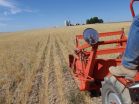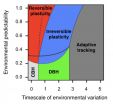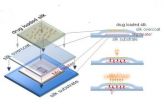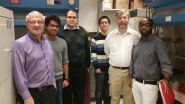INFORMATION:
Study finds way to conserve soil and water in world's driest wheat region
Changes can save soil, prevent sky-darkening dust storms
2014-11-24
(Press-News.org) LIND, Wash. - In the world's driest rainfed wheat region, Washington State University researchers have identified summer fallow management practices that can make all the difference for farmers, water and soil conservation, and air quality.
Wheat growers in the Horse Heaven Hills of south-central Washington farm with an average of 6-8 inches of rain a year. Wind erosion has caused blowing dust that exceeded federal air quality standards 20 times in the past 10 years.
"Some of these events caused complete brown outs, zero visibility, closed freeways," said WSU research agronomist Bill Schillinger.
Science to anchor farmer incentives
He and WSU agricultural economist Doug Young compared three fallow management systems in the western part of the Horse Heaven Hills with six inches of annual rainfall and the same practices in the eastern part with eight inches of rain.
The study was published in the Soil Science Society of America Journal.
The five-year study provides the U.S. Department of Agriculture's Natural Resources Conservation Service with science-based information needed to develop incentives for wheat farmers to change from traditional-tillage fallow practices to undercutter-tillage or no-till fallow systems.
Timing to trap moisture
Farmers in the Horse Heaven Hills practice a winter wheat-summer fallow rotation where only one crop is grown every other year on a given piece of land.
Average yields can be as low as 18 bushels per acre - compared to upwards of 120 bushels per acre in the higher rainfall area of the Palouse in eastern Washington. Though the margins are tight, with careful management wheat farming in the Horse Heaven Hills can be profitable.
To get the highest yield, farmers need to plant winter wheat in late August or early September after a year of fallow. The fallow period allows enough moisture from winter and spring rains to accumulate in the soil for seeds to get established.
"In east-central Washington, if you can't plant in late summer into deep seed-zone moisture in fallow, then you have to wait for fall rains in mid-October or later," Schillinger said.
The longer it takes to get winter wheat seedlings established, the lower the potential for good yields.
To help ensure precious soil moisture remains in the seeding zone, farmers till the soil in the spring. Tillage breaks up the capillary action of the soil; this helps slow soil moisture evaporation in the seed zone during the hot, dry summer months.
But too much tillage can cause soil loss through wind erosion that feeds hazardous dust storms.
Undercutting in the east
Compared to traditional tillage, Schillinger and Young found that undercutter tillage was the best option for fallow in the slightly moister eastern region of the Horse Heaven Hills, where late-August planting is possible and spring tillage helps retain summer soil moisture.
With wide, narrow-pitched, V-shaped blades, the undercutter slices beneath the soil surface to interrupt capillary action in the seed zone without causing much disturbance of the soil surface.
Schillinger said scientists and farmers have conclusively shown that spring tillage with the undercutter effectively retains seed-zone moisture. It also retains significantly greater surface residue and surface soil clods - which are less likely to be disturbed by wind and become airborne - compared to traditional tillage implements such as a tandem disk or field cultivator.
No till in the west
In the western region of the Horse Heaven Hills, the best option for controlling wind erosion was to practice no-till fallow; that is, to avoid tillage altogether. Most of the time, rainfall in this area simply isn't sufficient to establish an early stand of winter wheat with any fallow management system.
"There's no reason to till the soil when you already know in the spring that it will be too dry to plant wheat in late August," Schillinger said.
Economist Young found that, despite the modest grain yield potential, wheat farming in this environment can be profitable - with enough acreage and judicious use of inputs to manage costs. In fact, late-planted winter wheat on no-till fallow was just as profitable as traditional-tillage and undercutter-tillage fallow treatments at the western site.
ELSE PRESS RELEASES FROM THIS DATE:
Environmental 'tipping points' key to predicting extinctions
2014-11-24
Researchers from North Carolina State University have created a model that mimics how differently adapted populations may respond to rapid climate change. Their findings demonstrate that depending on a population's adaptive strategy, even tiny changes in climate variability can create a "tipping point" that sends the population into extinction.
Carlos Botero, postdoctoral fellow with the Initiative on Biological Complexity and the Southeast Climate Science Center at NC State and assistant professor of biology at Washington State University, wanted to find out how diverse ...
Penn team's game theory analysis shows how evolution favors cooperation's collapse
2014-11-24
Last year, University of Pennsylvania researchers Alexander J. Stewart and Joshua B. Plotkin published a mathematical explanation for why cooperation and generosity have evolved in nature. Using the classical game theory match-up known as the Prisoner's Dilemma, they found that generous strategies were the only ones that could persist and succeed in a multi-player, iterated version of the game over the long term.
But now they've come out with a somewhat less rosy view of evolution. With a new analysis of the Prisoner's Dilemma played in a large, evolving population, they ...
Wireless electronic implants stop staph, then dissolve
2014-11-24
MEDFORD/SOMERVILLE, Mass. (Nov. 24, 2014, 3 P.M.) -- Researchers at Tufts University, in collaboration with a team at the University of Illinois at Champaign-Urbana, have demonstrated a resorbable electronic implant that eliminated bacterial infection in mice by delivering heat to infected tissue when triggered by a remote wireless signal. The silk and magnesium devices then harmlessly dissolved in the test animals. The technique had previously been demonstrated only in vitro. The research is published online in the Proceedings of the National Academy of Sciences Early ...
JAX research team identifies new mechanism for misfolded proteins in heart disease
2014-11-24
A Jackson Laboratory research team has found that the misfolded proteins implicated in several cardiac diseases could be the result not of a mutated gene, but of mistranslations during the "editing" process of protein synthesis.
In 2006 the laboratory JAX Professor and Howard Hughes Medical Investigator Susan Ackerman, Ph.D., showed that the movement disorders in a mouse model with a mutation called sti (for "sticky," referring to the appearance of the animal's fur) were due to malformed proteins resulting from the incorporation of the wrong amino acids into proteins ...
Toxin targets discovered
2014-11-24
Research that provides a new understanding of how bacterial toxins target human cells is set to have major implications for the development of novel drugs and treatment strategies.
Cholesterol-dependent cytolysins (CDCs) are toxins produced by major bacterial pathogens, most notably Streptococcus pneumoniae and group A streptococci, which collectively kill millions of people each year.
The toxins were thought to work by interacting with cholesterol in target cell membranes, forming pores that bring about cell death.
Published today in the prestigious journal Proceedings ...
Muscle relaxant may be viable treatment for rare form of diabetes
2014-11-24
A commonly prescribed muscle relaxant may be an effective treatment for a rare but devastating form of diabetes, researchers at Washington University School of Medicine in St. Louis report.
The drug, dantrolene, prevents the destruction of insulin-producing beta cells both in animal models of Wolfram syndrome and in cell models derived from patients who have the illness.
Results are published Nov. 24 in the Proceedings of the National Academy of Sciences (PNAS) Online Early Edition.
Patients with Wolfram syndrome typically develop type 1 diabetes as very young children ...
UAlberta researchers stop 'vicious cycle of inflammation' that leads to tumor growth
2014-11-24
(Edmonton) A team of researchers from the University of Alberta has discovered a new approach to fighting breast and thyroid cancers by targeting an enzyme they say is the culprit for the "vicious cycle" of tumour growth, spread and resistance to treatment.
A team led by University of Alberta biochemistry professor David Brindley found that inhibiting the activity of an enzyme called autotaxin decreases early tumour growth in the breast by up to 70 per cent. It also cuts the spread of the tumour to other parts of the body (metastasis) by a similar margin. Autotaxin is ...
Obese children burdened by more than weight
2014-11-24
High blood pressure and nonalcoholic fatty liver disease (NAFLD) are two emerging health problems related to the epidemic of childhood obesity. In a recent study, researchers at University of California, San Diego School of Medicine sought to determine the prevalence of high blood pressure in children with NAFLD, which places them at risk for premature cardiovascular disease.
The study, published in the November 24 edition of PLOS ONE, found that children with NAFLD are at substantial risk for high blood pressure, which is commonly undiagnosed.
"As a result of our ...
New bird species confirmed 15 years after first observation
2014-11-24
PRINCETON, N.J.--A team led by researchers from Princeton University, Michigan State University and the Indonesian Institute of Sciences have confirmed the discovery of a new bird species more than 15 years after the elusive animal was first seen on the Indonesian island of Sulawesi.
The newly named Sulawesi streaked flycatcher (Muscicapa sodhii), distinguished by its mottled throat and short wings, was found in the forested lowlands of Sulawesi where it had last been observed. The researchers report in PLOS ONE that the new species is markedly different from other flycatchers ...
Study shows mental health impact of breast size differences in teens
2014-11-24
November 24, 2014 - Differences in breast size have a significant mental health impact in adolescent girls, affecting self-esteem, emotional well-being, and social functioning, reports the December issue of Plastic and Reconstructive Surgery®, the official medical journal of the American Society of Plastic Surgeons (ASPS).
More than just a "cosmetic issue," breast asymmetry can have negative psychological and emotional effects, according to the study by ASPS Member Surgeon Dr. Brian I. Labow and colleagues of Boston Children's Hospital. They suggest that early intervention ...
LAST 30 PRESS RELEASES:
Empty-handed neurons might cause neurodegenerative diseases
Black women hospitalised in USA with blood infection resistant to last-resort antibiotic at increased risk of death
NEC Society Statement on the Watson vs. Mead Johnson Verdict
Lemur’s lament: When one vulnerable species stalks another
Surf clams off the coast of Virginia reappear – and rebound
Studying optimization for neuromorphic imaging and digital twins
ORNL researchers win Best Paper award for nickel-based alloy tailoring
New beta-decay measurements in mirror nuclei pin down the weak nuclear force
Study uncovers neural mechanisms underlying foraging behavior in freely moving animals
Gene therapy is halting cancer. Can it work against brain tumors?
New copper-catalyzed C-H activation strategy from Scripps Research
New compound from blessed thistle promotes functional nerve regeneration
Auburn’s McCrary Institute, ORNL to partner on first regional cybersecurity center to protect the nation’s electricity grid
New UNC-Chapel Hill study examines the increased adoption of they/them pronouns
Groundbreaking study reveals potential diagnostic marker for multiple sclerosis years before symptom onset
Annals of Internal Medicine presents breaking scientific news at ACP’s Internal Medicine Meeting 2024
Scientists discover new way to extract cosmological information from galaxy surveys
Shoe technology reduces risk of diabetic foot ulcers
URI-led team finds direct evidence of ‘itinerant breeding’ in East Coast shorebird species
Wayne State researcher aims to improve coding peer review practices
Researchers develop a new way to safely boost immune cells to fight cancer
Compact quantum light processing
Toxic chemicals from microplastics can be absorbed through skin
New research defines specific genomic changes associated with the transmissibility of the monkeypox virus
Registration of biological pest control products exceeds that of agrochemicals in Brazil
How reflecting on gratitude received from family can make you a better leader
Wearable technology assesses surgeons’ posture during surgery
AATS and CRF® partner on New York Valves: The structural heart summit
Postpartum breast cancer and survival in women with germline BRCA pathogenic variants
Self-administered acupressure for probable knee osteoarthritis in middle-aged and older adults
[Press-News.org] Study finds way to conserve soil and water in world's driest wheat regionChanges can save soil, prevent sky-darkening dust storms





